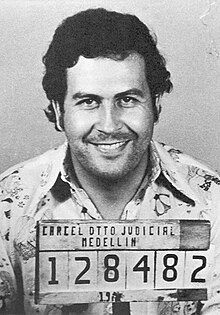
Back Pablo Escobar Afrikaans بابلو إسكوبار Arabic پابلو إسكوبار ARY بابلو اسكوبار ARZ Pablo Escobar AST Pablo Eskobar Azerbaijani Pablo Escobar BAT-SMG Pablo Escobar BCL Пабла Эскабар Byelorussian Паблё Эскабар BE-X-OLD
Pablo Escobar | |
|---|---|
 Escobar in a 1976 mugshot | |
| Born | Pablo Emilio Escobar Gaviria 1 December 1949 Rionegro, Colombia |
| Died | 2 December 1993 (aged 44) Medellín, Colombia |
| Cause of death | Gunshot wound to the head |
| Resting place | Monte Sacro Cemetery |
| Spouse |
Maria Victoria Henao
(m. 1976) |
| Children |
|
| Other names |
|
| Organization | Medellín cartel |
| Conviction(s) | Illegal drug trade, assassinations, bombing, bribery, racketeering, murder |
| Criminal penalty | Five years' imprisonment |
| Signature | |
 | |
Pablo Emilio Escobar Gaviria (/ˈɛskəbɑːr/; Spanish: [ˈpaβlo eskoˈβaɾ]; 1 December 1949 – 2 December 1993) was a Colombian drug lord, narcoterrorist, and politician, who was the founder and sole leader of the Medellín Cartel. Dubbed "the king of cocaine", Escobar was one of the wealthiest criminals in history, having amassed an estimated net worth of US$30 billion by the time of his death—equivalent to $70 billion as of 2022—while his drug cartel monopolized the cocaine trade into the United States in the 1980s and early 1990s.[1][2]
Born in Rionegro and raised in Medellín, Escobar studied briefly at Universidad Autónoma Latinoamericana of Medellín, but left without graduating; he instead began engaging in criminal activity, selling illegal cigarettes and fake lottery tickets, as well as participating in motor vehicle theft. In the early 1970s, he began to work for various drug smugglers, often kidnapping and holding people for ransom.
In 1976, Escobar founded the Medellín Cartel, which distributed powder cocaine, and established the first smuggling routes from Peru, Bolivia and Ecuador, through Colombia and eventually into the United States. Escobar's infiltration into the U.S. created exponential demand for cocaine and by the 1980s it was estimated Escobar led monthly shipments of 70 to 80 tons of cocaine into the country from Colombia. As a result, he quickly became one of the richest people in the world,[1][3] but constantly battled rival cartels domestically and abroad, leading to massacres and the murders of police officers, judges, locals, and prominent politicians.[4]
In the 1982 Colombian parliamentary election, Escobar was elected as an alternate member of the Chamber of Representatives as part of the Liberal Party. Through this, he was responsible for community projects such as the construction of houses and football fields, which gained him popularity among the locals of the towns that he frequented. However, Escobar's political ambitions were thwarted by the Colombian and U.S. governments, who routinely pushed for his arrest, with Escobar widely believed to have orchestrated the Avianca Flight 203 and DAS Building bombings in retaliation.
In 1991, Escobar surrendered to authorities, and was sentenced to five years' imprisonment on a host of charges, but struck a deal of no extradition with Colombian President César Gaviria, with the ability of being housed in his own, self-built prison, La Catedral. In 1992, Escobar escaped and went into hiding when authorities attempted to move him to a more standard holding facility, leading to a nationwide manhunt.[5] As a result, the Medellín Cartel crumbled, and in 1993, Escobar was killed in his hometown by Colombian National Police, a day after his 44th birthday.[6]
Escobar's legacy remains controversial; while many denounce the heinous nature of his crimes, he was seen as a "Robin Hood-like" figure for many in Colombia, as he provided many amenities to the poor. His killing was mourned and his funeral attended by over 25,000 people.[7] Additionally, his private estate, Hacienda Nápoles, has been transformed into a theme park.[8] His life has also served as inspiration for or has been dramatized widely in film, television, and in music.
- ^ a b Macias, Amanda (21 September 2015). "10 facts reveal the absurdity of Pablo Escobar's wealth". businessinsider.com. Insider Inc. Archived from the original on 18 October 2023. Retrieved 28 July 2018.
- ^ "Here's How Rich Pablo Escobar Would Be If He Was Alive Today". UNILAD. 13 September 2016. Archived from the original on 29 July 2018. Retrieved 28 July 2018.
- ^ Escobar, Juan Pablo (2014). Pablo Escobar, My Father. New York: St. Martin's Press. p. 469.
- ^ "Pablo Escobar Gaviria – English Biography – Articles and Notes". ColombiaLink.com. Archived from the original on 8 November 2006. Retrieved 16 March 2011.
- ^ "Familiares exhumaron cadáver de Pablo Escobar para verificar plenamente su identidad". El Tiempo.[permanent dead link]
- ^ "Decline of the Medellín Cartel and the Rise of the Cali Mafia". U.S. Drug Enforcement Administration. Archived from the original on 18 January 2006. Retrieved 13 February 2010.
- ^ "Pablo Escobar: Biography". Biography.com. Archived from the original on 30 June 2023. Retrieved 17 July 2019.
- ^ "Escobar's Former Mansion Will Now Be A Theme Park". Medellín Living. 13 January 2014. Archived from the original on 18 October 2023. Retrieved 17 July 2019.
© MMXXIII Rich X Search. We shall prevail. All rights reserved. Rich X Search